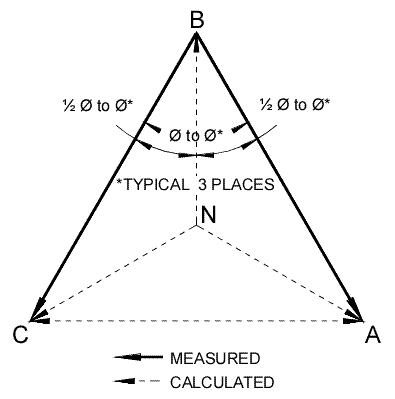I have been working with a power meter recently that has the voltage inputs from an "Open Delta" 3-wire PT arrangement. When I'm looking at the metering mode of the relay I can see all of the L-L voltage readings shown on the meter (4.16kV) However when I'm using the trigger trace function of the meter and the meter is displaying raw data I can only see waveforms for Va and Vc and see nothing for Vb.
When asking Multilin about this (Multilin PQMII Meter) they give me the following explanation: "On an 2PT open-delta the only two voltages that are derived from the power system are Vab and Vcb. With these two avaliable the meter calculates the thrid missing voltage Vca by vectorally adding the two measured voltages. The metering screen is thus displaying only a calculated value for the third Vca voltage."
Is this correct? If you know two voltage phasors can you add them to calculate the third?
I understand the use of the phasor Vab, but why is Vcb used instead of Vbc? I always thought that Vbc was used for the "Vb" or second voltage phasor?
When looking at the raw data in the trigger trace function it shows single Va, Vb, and Vc phasors with L-L values. It used this single L-N nomenclature except they are actually L-L voltage phasors. There are waveforms that appear for Va and Vc but not for Vb. They are saying that this is the one that is calculated and that it is not shown as part of the raw voltage data. However if Vca is the phasor that is calculated according to their statement above, then why would Vb be the missing phasor on the waveform plot as opposed to Vc?
Can anyone help clear this up?
When asking Multilin about this (Multilin PQMII Meter) they give me the following explanation: "On an 2PT open-delta the only two voltages that are derived from the power system are Vab and Vcb. With these two avaliable the meter calculates the thrid missing voltage Vca by vectorally adding the two measured voltages. The metering screen is thus displaying only a calculated value for the third Vca voltage."
Is this correct? If you know two voltage phasors can you add them to calculate the third?
I understand the use of the phasor Vab, but why is Vcb used instead of Vbc? I always thought that Vbc was used for the "Vb" or second voltage phasor?
When looking at the raw data in the trigger trace function it shows single Va, Vb, and Vc phasors with L-L values. It used this single L-N nomenclature except they are actually L-L voltage phasors. There are waveforms that appear for Va and Vc but not for Vb. They are saying that this is the one that is calculated and that it is not shown as part of the raw voltage data. However if Vca is the phasor that is calculated according to their statement above, then why would Vb be the missing phasor on the waveform plot as opposed to Vc?
Can anyone help clear this up?

